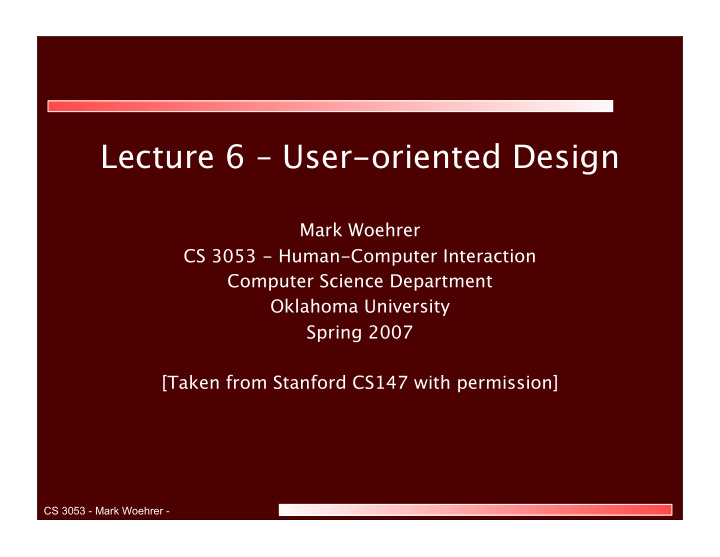



Lecture 6 – User-oriented Design Mark Woehrer CS 3053 - Human-Computer Interaction Computer Science Department Oklahoma University Spring 2007 [Taken from Stanford CS147 with permission] CS 3053 - Mark Woehrer -
Prototyping NEEDS DESIG N EVALUATE IMPLEMENT CS 3053 - Mark Woehrer -
Using Prototypes • Allows multiple parties to envision together – Designers – Users – Engineering, marketing, planning,….. • Reflective conversation with the materials • Focus for identifying alternatives and tradeo fg s CS 3053 - Mark Woehrer -
Low-Fidelity “Paper” Prototype NEEDS DESIG N EVALUATE IMPLEMENT CS 3053 - Mark Woehrer -
Tools • Paper, Cardboard, Transparencies • Tape, Glue, Rubber Cement • Pens, Pencils, Markers • Scissors • Plastic Tubes, Paper Cups, CD “Coasters” • Anything that you can buy in an arts and crafts store (and that a kindergartener would have fun using). CS 3053 - Mark Woehrer -
Examples: Low-Fidelity Prototype CS 3053 - Mark Woehrer -
Examples: Low-Fidelity Prototype http://www.mindspring.com/~bryce_g/projects/lo_fi.html CS 3053 - Mark Woehrer -
Examples: Low-Fidelity Prototype http://bmrc.berkeley.edu/courseware/cs160/fall99/projects/t4/body/low-fi/ CS 3053 - Mark Woehrer -
User Testing NEEDS DESIG N EVALUATE IMPLEMENT CS 3053 - Mark Woehrer -
Tools • 3-4 group members • Greeter/Facilitator • Computer (not necessary for low-fi testing) • 2 Observers/Note takers • Prototype • Users!!!! CS 3053 - Mark Woehrer -
User Testing http://www.cs.waikato.ac.nz/usability/facilities.html http://www.itl.nist.gov/iad/gallery.html CS 3053 - Mark Woehrer -
High Fidelity “Interactive” Prototype NEEDS DESIG N EVALUATE IMPLEMENT CS 3053 - Mark Woehrer -
Tools • HTML & Javascript • Java JFC/Swing • Visual C++, Visual Basic • Flash MX, Director • Mac Interface Builder • others…or a mix of the above!!! CS 3053 - Mark Woehrer -
Examples: Interactive Prototype From cs247a at Stanford University CS 3053 - Mark Woehrer -
Examples: Interactive Prototype From cs160 at UC Berkeley CS 3053 - Mark Woehrer -
Examples of Projects • Visual Voicemail • Interactive Academic Planner • Suzie Q • ToneDeaf Revolution CS 3053 - Mark Woehrer -
Appendix Details on each of the data gathering techniques CS 3053 - Mark Woehrer -
Getting Users Involved NEEDS DESIGN EVALUATE IMPLEMENT USE CS 3053 - Mark Woehrer -
Stages of User Involvement • Need finding • Design [Participatory design] • Implementation [End-user programming] • Evaluation • Use in the target setting Users can be involved in any of the stages of the Design Process! CS 3053 - Mark Woehrer -
An Overview of Data Gathering Techniques • Questionnaires • Interviews • Focus groups • Observation – Naturalistic (ethnography) – Controlled (laboratory) • Studying documentation (artifacts) CS 3053 - Mark Woehrer -
Questionnaires • Qualitative vs. quantitative data • Motivation to complete – Response rate • Uses of on-line questionnaires • Good for demographics, evaluation of specific features or properties • Design of Scales – Precision – E fg ort needed to decide on a response See the detailed questionnaire guidelines in the text CS 3053 - Mark Woehrer -
Likert Scales and Semantic Differentials How easy was the system to use? Easy Difficult 1 2 3 4 5 6 7 The system was easy to use Strongly Strongly Agree Neutral Disagree Agree Disagree How easy was the system to use? Easy___________________________________Difficult CS 3053 - Mark Woehrer -
Interviews • Degrees of structuring for di fg erent purposes – Structured - Like a guided questionnaire – Semi-structured - Basic script guides the conversation – Open-ended - Still has a goal and focus • Phone or face-to-face • Develop trust – Be sensitive to the setting – Explain your goals to the interviewee See the detailed interviewing guidelines in the text CS 3053 - Mark Woehrer -
Focus groups • Group Interviews – Can be 2 or more • Try to work with representatives of intended users • Try to bring out di fg erences • Require expert facilitation CS 3053 - Mark Woehrer -
Naturalistic observation • “Quick-and-dirty” • Participant observation (ethnography) – Insider-outsider spectrum • User camera studies • Diaries and pager studies • Audio/video recording • Walkthroughs Many ethical issues are involved and it is important to have full user understanding and agreement to what you are doing CS 3053 - Mark Woehrer -
Insights from ethnography • Seeing what is invisible to inhabitants – What they say vs. what they do • The Heisenberg principle – Observation changes what is being observed CS 3053 - Mark Woehrer -
Observational Data Gathering • Notes • Camera • Audio • Video – Good for presentations, hard to analyze – It’s the AUDIO, stupid. • Diaries – User diaries • Logs CS 3053 - Mark Woehrer -
Controlled observation • Laboratory settings and tasks • Techniques for understanding what the user is doing – Walkthroughs – Think-aloud – Paired-think-aloud More to come when we talk about testing CS 3053 - Mark Woehrer -
Studying documentation (artifacts) • O ffj cial documentation/description • Physical and digital artifacts in the environment CS 3053 - Mark Woehrer -
Data Gathering Guidelines • Set clear goals for the data collection – Focus on identifying the stakeholders’ needs • Involve all the stakeholder groups • Evaluate cost/benefit for your e fg ort – Understand the tradeo fg s – Use a combination of techniques – Balance specific goals and openness • Support data-gathering with appropriate props • Run a pilot trial CS 3053 - Mark Woehrer -
Recommend
More recommend